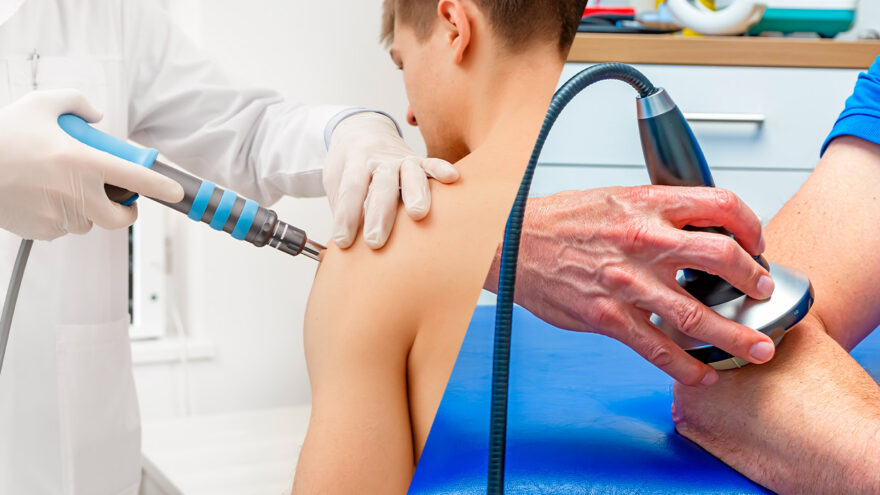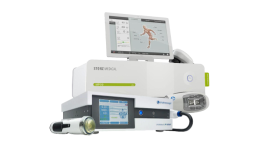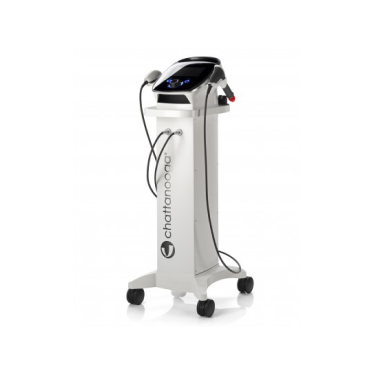Extracorporeal Shockwave Therapy (ESWT) is a non-invasive treatment using acoustic waves to address various musculoskeletal conditions and stimulate the body’s natural healing process. These waves are transmitted in three-dimensional space and convert mechanical pressure into biological signals that trigger tissue repair and regeneration.
Initially used to break up kidney stones, ESWT is now used to treat a variety of conditions such as:
- Musculoskeletal Conditions
- Tendinopathies / Enthesopathies
- Bone-Related Conditions
- Joint and Ligament Disorders
- Soft Tissue / Fascia Disorders
- Neurological / Pain Syndromes
- Urological / Men’s Health
- Dermatological / Wound Healing
- Vascular / Circulatory
- Veterinary Applications
There are two primary types of ESWT:
- Radial Pressure Wave (RPW) Therapy – Energy disperses outward, weaker at depth.
- Focused Shockwave Therapy (FSWT) – Energy is concentrated at specific tissue depths.
Your choice between RSWT and FSWT affects treatment success, patient outcomes, and clinical efficiency.
Radial Shockwave Therapy (RSWT)

Radial shockwave therapy (RSWT) uses air pressure to create gentle waves that spread from where the device touches the skin. A small part inside the device is pushed forward by compressed air and hits a metal piece against the skin, sending sound waves into the body. These waves are strongest at the surface and slowly weaken as they go deeper. They usually reach about 3 to 4 centimeters deep, making RSWT a good option for treating problems close to the body’s surface.
Application of Radial Shockwave Therapy
The treatment is easy to conduct in the following way:
- A handheld device is pressed against the skin over the area being treated.
- The device sends out a series of pulsed pressure waves.
- The waves are generated by compressed air inside the machine.
- The waves spread through the surrounding tissue to stimulate healing, reduce pain, and improve mobility.
- Effective treatment depth is 3–4 cm.
- Each session typically lasts 5 to 10 minutes and may cause mild discomfort, but it’s generally well tolerated.
Ideal For:
The most common conditions treated by Radial ESWT Therapy are superficial musculoskeletal conditions, including:
- Plantar fasciitis
- Achilles tendinopathy (mid-portion)
- Patellar tendinopathy (jumper’s knee)
- Tennis elbow (lateral epicondylitis)
- Shoulder tendinopathy (e.g., supraspinatus)
- Myofascial trigger points (neck, back, shoulder)
- Iliotibial band syndrome (on the outer side of the knee, caused by overuse)
- Scar tissue adhesions
Benefits
The advantages of RSWT include cost-effectiveness, user-friendly application, and the ability to treat larger surface areas in a single session. The equipment is generally more affordable than focused shockwave devices, making it an accessible entry point for practices new to shockwave therapy.
Practical Advantages:
- Lower-cost devices
- Covers larger treatment areas
- Easy to use: excellent for entry-level adoption
The broader energy dispersion pattern means practitioners can efficiently address larger treatment zones, providing a practical solution for common superficial musculoskeletal conditions. Radial shockwave therapy also:
- Stimulates circulation and healing
- Reduces inflammation
- Breaks up adhesions and calcifications
Focused Shockwave Therapy (FSWT)
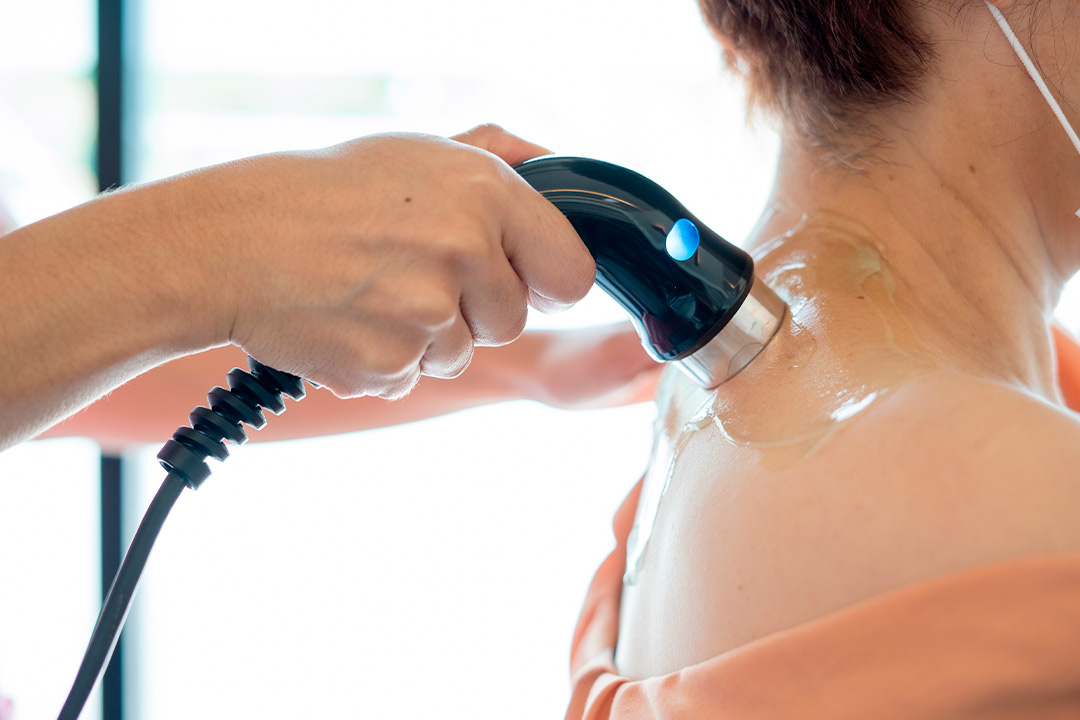
Focused shockwave therapy (FSWT) directs high-energy acoustic waves to precise locations within the body. Unlike radial therapy, focused shockwaves are generated electromagnetically, electrohydraulically, or piezoelectrically, then concentrated to a specific focal point. This creates a powerful energy peak followed by negative pressure, enabling penetration depths up to 12cm while minimizing surface tissue discomfort.
Application of Focused Shockwave Therapy
The application process for focused ESWT is quite similar to radial ESWT in setup and patient experience. The patient is positioned comfortably, and a conductive gel is applied to the precise treatment area to help transmit the shockwaves. A handheld applicator is placed against the skin to deliver the focused waves. While the equipment and energy penetration differ, focused ESWT targets deeper tissues more precisely. The procedure is quick, typically lasting 5 to 15 minutes, and involves minimal discomfort. Multiple sessions may be scheduled depending on the condition being treated.
- Produced electromagnetically, electrohydraulically, or piezoelectrically
- Focuses energy at precise tissue depths, up to 12 cm
- Penetrates deeper with minimal surface discomfort
Ideal For:
Clinically, FSWT excels in treating deeper, more localized pathologies. It’s particularly effective for bone-related conditions. Research demonstrates its superiority in treating deep tendinopathies, calcifications, and chronic conditions that are resistant to other therapies.
Focused shockwaves have shown promise in treating erectile dysfunction by stimulating neovascularization. The most common conditions treated by focused shockwave therapy include deep or chronic conditions, such as:
- Chronic Achilles tendinopathy (especially insertional)
- Calcific shoulder tendinopathy
- Patellar tendinopathy (jumper’s knee)
- Non-healing bone fractures (non-unions)
- Plantar fasciitis (severe or resistant cases)
- Erectile dysfunction (vasculogenic)
- Chronic low back pain
- Bone marrow edema (excess fluid builds up in the bone marrow due to injury)
- Avascular necrosis (bone tissue dies due to a lack of blood supply)
Benefits
The key benefits of FSWT include precise targeting at millimeter-level accuracy, adjustable depth penetration, and stimulation of cellular healing mechanisms. The treatment helps release tiny gas bubbles and nitric oxide in the tissue, which boosts cell activity and helps reduce inflammation.
For practices treating complex orthopedic cases or chronic conditions, focused shockwave therapy offers a powerful non-invasive intervention with documented long-term efficacy and includes:
- Pinpoint accuracy (millimeter-level)
- Triggering nitric oxide production
- Potent anti-inflammatory and regenerative effects
- Fewer sessions required
The Best Fit for Your Practice
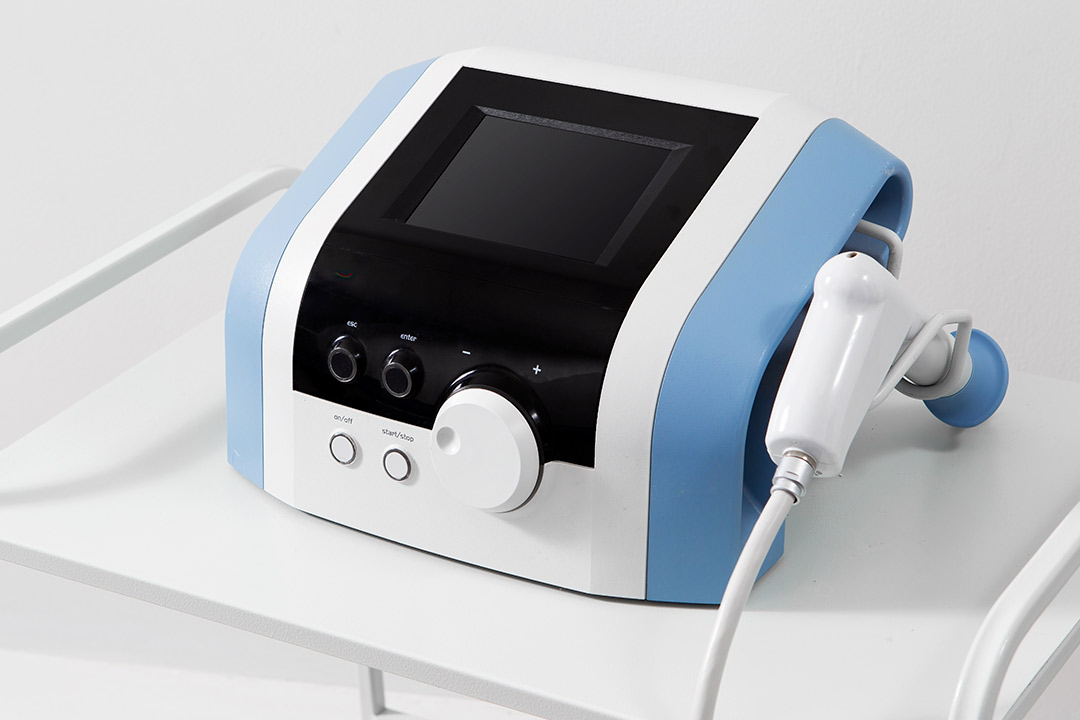
When deciding between radial and focused shockwave therapy for your practice, understanding their fundamental differences is crucial for optimal patient outcomes. Clinical evidence indicates that while both technologies are effective, they serve different purposes and patient populations.
Consider:
Patient Needs:
- FSWT is better for deeper conditions (e.g., rotator cuff injuries).
- RSWT is ideal for larger, superficial treatment areas.
Practice Demographics:
- Sports medicine? → FSWT.
- General or physio clinic? → RSWT may suffice.
A Side-by-Side Comparison
The table below compares key features of radial and focused shockwave therapy, including effectiveness, patient comfort, return on investment (ROI), and ideal clinical applications. Use this side-by-side overview to help determine which technology best suits your practice and patients’ needs.
| Feature | Radial Shockwave (RSWT) | Focused Shockwave (FSWT) |
| Penetration Depth | 3–4 cm (superficial) | Up to 12 cm (deep tissues) |
| Energy Distribution | Divergent, spread-out | Convergent, highly targeted |
| Ideal Conditions | Trigger points, superficial tendinopathies | Chronic, deep tissue, bone-related pathologies |
| Patient Comfort | Can be more uncomfortable | Typically better tolerated |
| Equipment Cost | Lower initial cost | Higher investment |
| Treatment Duration | Typically 3–10 sessions | Fewer sessions needed (often 3–6) |
| Application | Soft tissue injuries, muscle pain, and sports recovery | Bone injuries, deep tendinopathies, and erectile dysfunction |
| Effectiveness | Effective for surface-level conditions | More effective for chronic or deep-seated conditions |
| ROI for Practice | Faster return due to lower cost & broad use | Higher per-session billing, long-term ROI with specialty care |
Why Many Clinics Use Both
When selecting shockwave technology for your practice, consider the benefits of both. The gold standard emerging in clinical practice is the integration of both technologies, using radial waves for superficial structures and focused waves for targeting the source of injury.
Combining RSWT and FSWT offers the best of both worlds:
- RSWT for broad superficial treatment
- FSWT for targeted, deep interventions
Elevate Your Practice
Enhance your clinic with cutting-edge technology. Discover how combining Radial and Focused Shockwave Therapy can transform your treatment approach. Learn more at Shockwave Source and empower your patients with modern, effective, non-invasive care.

